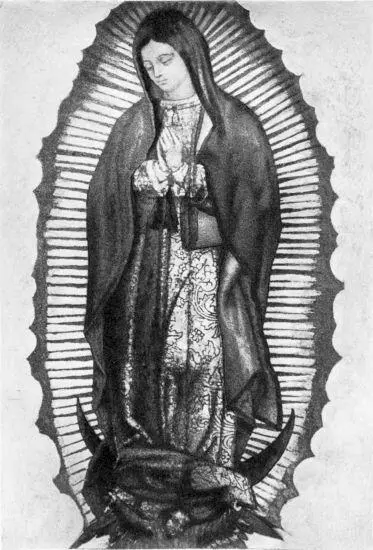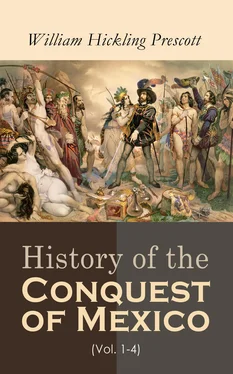The discipline of children, especially at the public schools, as stated in a previous chapter, was exceedingly severe. [250]But after she had come to a mature age the Aztec maiden was treated by her parents with a tenderness from which all reserve seemed banished. In the counsels to a daughter about to enter into life, they conjured her to preserve simplicity in her manners and conversation, uniform neatness in her attire, with strict attention to personal cleanliness. They inculcated modesty, as the great ornament of a woman, and implicit reverence for her husband; softening their admonitions by such endearing epithets as showed the fulness of a parent’s love. [251]
Polygamy was permitted among the Mexicans, though chiefly confined, probably, to the wealthiest classes. [252]And the obligations of the marriage vow, which was made with all the formality of a religious ceremony, were fully recognized, and impressed on both parties. The women are described by the Spaniards as pretty, unlike their unfortunate descendants of the present day, though with the same serious and rather melancholy cast of countenance. Their long black hair, covered, in some parts of the country, by a veil made of the fine web of the pita , might generally be seen wreathed with flowers, or, among the richer people, with strings of precious stones, and pearls from the Gulf of California. They appear to have been treated with much consideration by their husbands, and passed their time in indolent tranquillity, or in such feminine occupations as spinning, embroidery, and the like, while their maidens beguiled the hours by the rehearsal of traditionary tales and ballads. [253]
The women partook equally with the men of social festivities and entertainments. These were often conducted on a large scale, both as regards the number of guests and the costliness of the preparations. Numerous attendants, of both sexes, waited at the banquet. The halls were scented with perfumes, and the courts strewed with odoriferous herbs and flowers, which were distributed in profusion among the guests, as they arrived. Cotton napkins and ewers of water were placed before them, as they took their seats at the board; for the venerable ceremony of ablution [254]before and after eating was punctiliously observed by the Aztecs. [255]Tobacco was then offered to the company, in pipes, mixed up with aromatic substances, or in the form of cigars, inserted in tubes of tortoise-shell or silver. They compressed the nostrils with the fingers, while they inhaled the smoke, which they frequently swallowed. Whether the women, who sat apart from the men at table, were allowed the indulgence of the fragrant weed, as in the most polished circles of modern Mexico, is not told us. It is a curious fact that the Aztecs also took the dried leaf in the pulverized form of snuff. [256]
The table was well provided with substantial meats, especially game; among which the most conspicuous was the turkey, erroneously supposed, as its name imports, to have come originally from the East. [257]These more solid dishes were flanked by others of vegetables and fruits, of every delicious variety found on the North American continent. The different viands were prepared in various ways, with delicate sauces and seasoning, of which the Mexicans were very fond. Their palate was still further regaled by confections and pastry, for which their maize-flour and sugar supplied ample materials. One other dish, of a disgusting nature, was sometimes added to the feast, especially when the celebration partook of a religious character. On such occasions a slave was sacrificed, and his flesh, elaborately dressed, formed one of the chief ornaments of the banquet. Cannibalism, in the guise of an Epicurean science, becomes even the more revolting. [258]
The meats were kept warm by chafing-dishes. The table was ornamented with vases of silver, and sometimes gold, of delicate workmanship. The drinking-cups and spoons were of the same costly materials, and likewise of tortoise-shell. The favorite beverage was the chocolatl , flavored with vanilla and different spices. They had a way of preparing the froth of it, so as to make it almost solid enough to be eaten, and took it cold. [259]The fermented juice of the maguey, with a mixture of sweets and acids, supplied, also, various agreeable drinks, of different degrees of strength, and formed the chief beverage of the elder part of the company. [260]
As soon as they had finished their repast, the young people rose from the table, to close the festivities of the day with dancing. They danced gracefully, to the sound of various instruments, accompanying their movements with chants of a pleasing though somewhat plaintive character. [261]The older guests continued at table, sipping pulque , and gossiping about other times, till the virtues of the exhilarating beverage put them in good humor with their own. Intoxication was not rare in this part of the company, and, what is singular, was excused in them, though severely punished in the younger. The entertainment was concluded by a liberal distribution of rich dresses and ornaments among the guests, when they withdrew, after midnight, “some commending the feast, and others condemning the bad taste or extravagance of their host; in the same manner,” says an old Spanish writer, “as with us.” [262]Human nature is, indeed, much the same all the world over.
In this remarkable picture of manners, which I have copied faithfully from the records of earliest date after the Conquest, we find no resemblance to the other races of North American Indians. Some resemblance we may trace to the general style of Asiatic pomp and luxury. But in Asia, woman, far from being admitted to unreserved intercourse with the other sex, is too often jealously immured within the walls of the harem. European civilization, which accords to this loveliest portion of creation her proper rank in the social scale, is still more removed from some of the brutish usages of the Aztecs. That such usages should have existed with the degree of refinement they showed in other things is almost inconceivable. It can only be explained as the result of religious superstition; superstition which clouds the moral perception, and perverts even the natural senses, till man, civilized

OUR LADY OF GUADALOUPE
Goupil & Cº. Paris
man, is reconciled to the very things which are most revolting to humanity. Habits and opinions founded on religion must not be taken as conclusive evidence of the actual refinement of a people.
The Aztec character was perfectly original and unique. It was made up of incongruities apparently irreconcilable. It blended into one the marked peculiarities of different nations, not only of the same phase of civilization, but as far removed from each other as the extremes of barbarism and refinement. It may find a fitting parallel in their own wonderful climate, capable of producing, on a few square leagues of surface, the boundless variety of vegetable forms which belong to the frozen regions of the North, the temperate zone of Europe, and the burning skies of Arabia and Hindostan.
One of the works repeatedly consulted and referred to in this Introduction is Boturini’s Idea de una nueva Historia general de la América Septentrional . The singular persecutions sustained by its author, even more than the merits of his book, have associated his name inseparably with the literary history of Mexico. The Chevalier Lorenzo Boturini Benaduci was a Milanese by birth, of an ancient family, and possessed of much learning. From Madrid, where he was residing, he passed over to New Spain, in 1735, on some business of the Countess of Santibañez, a lineal descendant of Montezuma. While employed on this, he visited the celebrated shrine of Our Lady of Guadaloupe, and, being a person of devout and enthusiastic temper, was filled with the desire of collecting testimony to establish the marvellous fact of her apparition. In the course of his excursions, made with this view, he fell in with many relics of Aztec antiquity, and conceived—what to a Protestant, at least, would seem much more rational—the idea of gathering together all the memorials he could meet with of the primitive civilization of the land.
Читать дальше













